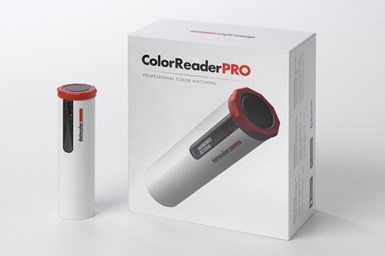Q. What is color management, how does it work and why is it important to the powder coating supply chain?

Throughout the powder coatings supply chain, the use of digital color management technology, such as spectrophotometers, is becoming more common. Photo Credit: Datacolor
A. Color is an important factor in many sectors of the paint and coatings industry and especially so for powder coatings, which are applied as dry powder and typically create a harder, tougher finish than conventional liquid paint. Powder continues to grow in popularity, representing around 20% of the coatings segment, leading to an increased demand for color matching.
The color development process for powder coatings can be time-consuming and sometimes difficult, especially if there is error. Due to the complexity of the color matching process, color management plays a critical role in the powder coating industry. That is where software for digital color solutions (like colorimeters and spectrophotometers), formulation and quality control come into play.
Color management 101
Color management refers to the solutions that measure, analyze, communicate and assess color information. Leveraging digital color management solution helps manufacturers reduce time and effort spent on formulation and color control, eliminate costly errors and deliver quality products in the most efficient way possible. Different color management products are tailored to different industry requirements, but the goal of most solutions is to measure and evaluate color to create and communicate objective color data.
Utilizing color management technology, including hardware and software, is crucial to delivering color accuracy while guaranteeing performance. However, developing a color for powder coating takes significantly more time than in other segments of the coatings industry. For example, developing a color in architectural coatings takes minutes. Manufacturers dispense colorants into a base, mix, shake and apply at the point of sale. If the color is wrong, it can easily be corrected by adding colorant to the existing batch. In powder coating, on the other hand, a large amount of time is dedicated to getting color right; on a laboratory scale, developing just one color can take an hour. One must weigh the dry material, create a premix, extrude the premix and so on. It is a lengthy process, and if the color is incorrect, this entire process needs to restart — going back to correct the color is not possible.
There are also a few nuances when it comes to measuring and developing color in powder. For example, architectural or decorative coatings are often made by mixing colorants and base paints at the point of sale; architectural coatings companies produce the base paints, colorants and the color formulations. In this model, the delivery of the color recipe to the point of sale shop is the critical step. Powder coatings are a bit different; they are fully manufactured in factories and shipped ready to apply. Factories are responsible for adjusting formulations, which makes accurate, efficient color measurement from the start a critical step in powder.
Because of this, speed and color communication are important considerations. It is crucial that color is correct and approved by the customer the first time around. Most color labs have some sort of color management equipment already, but some smaller companies are still assessing color visually. Visual color evaluation is subjective and can lead to costly errors — something these companies desperately need to avoid. With the right color management solutions in place, manufacturers can overcome the time and resource-intensive process associated with getting color right.
Digitalization is key
Throughout the powder coatings supply chain, the use of digital standards and color management technology is more common today. Without computerized color solutions, companies cannot be responsive to the market or maintain quality color delivery, and it could take days before a manufacturer realizes they cannot match a specified color. With digital tools, if the manufacturer does not have the appropriate raw materials on hand to make a specific color, they will know immediately, saving time and money.
Advancements in digital technology have streamlined digital color communication throughout the supply chain. Without a digitalized database that can be used to give accurate computerized formula predictions, manufacturers wind up managing color manually and potentially picking more expensive raw materials to begin the color development process.
Large powder coatings manufacturers have different different factories and laboratories around the world. For efficiency purposes, these companies strive to balance workload by moving production from one factory to another. Companies do not want to spend time repeatedly matching the same colors at different sites, so centralizing color matching and communication is key. All factories and labs need access to this core data, something that is made possible through digitalized databases. Centralized digital color communication helps users quickly shift production from one site to another between different powder coating factories.

An example of a portable color measurement device. Photo Credit: Datacolor
Technology also continues to evolve to meet the needs of the industry. With the introduction of sophisticated portable color measurement devices, companies are now able to measure a color and immediately receive a match in a fan deck that is within the structure of the product. From there, they can receive job costs quickly from labs, which in turn enables higher sales volume.
The color-matching process in powder coating is complex, which is why color management, specifically digital color management, plays such a critical role in the industry. Digital color management allows higher accuracy of color predictions in powder, so, ideally, factories can go from color formula prediction straight to manufacturing with little to no error, ultimately saving time and money. Color management is important to powder coating and gives manufacturers confidence in their color quality from supplier to customer.
About the Author
Rik Mertens
Rik Mertens is the Global Applications Manager at Datacolor and has more than 30 years of experience in the color industry. Datacolor is a global leader in color management solutions and provides software, instruments and services to assure accurate color of materials, products and images. The world’s leading brands, manufacturers and creative professionals have used Datacolor’s innovative solutions to consistently achieve the right color for more than 50 years. Industries served include textile and apparel, paint and coatings, automotive and plastics as well as photography, design and videography. For more information, visit: datacolor.com.
Related Content
Adjusting Current and Voltage When Powder Coating
Which manual powder coating gun setting is better to adjust, voltage or current? Jeff Hale of Gema USA discusses when to use different settings on your powder gun to achieve optimal results.
Read MoreSurface Prep Solution for Rusted Rebar in Concrete
Julie Holmquist of Cortec Corporation discusses passivating corrosion on rebar and other reinforcing metals.
Read MoreCorrosion Resistance Testing for Powder Coating
Salt spray can be useful to help compare different pretreatment methods and coatings but it does not tell us much about the corrosion resistance of a part over time in the field. Powder coating expert Rodger Talbert offers insights into how to get a better idea of how to improve a part’s corrosion resistance in the real world.
Read MoreTrivalent Chrome Overview
As the finishing industry begins to move away from the use of hexavalent chromium to trivalent chromium, what factors should finishers consider as they make new investments? Mark Schario, chief technology officer for Columbia Chemical offers a helpful overview of this complicated topic.
Read MoreRead Next
Antimicrobial Powder Coatings from Powder Technology Inc.
Powder Technology Inc. added antimicrobial powder coating to their offerings, using BioCote technology. In the time of COVID-19, antimicrobial technology is in demand.
Read More



















